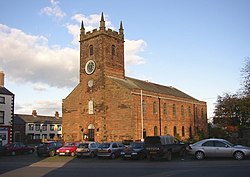Wigton
| Wigton | |
| Cumberland | |
|---|---|
 St Mary's, Wigton | |
| Location | |
| Grid reference: | NY255481 |
| Location: | 54°49’23"N, 3°9’32"W |
| Data | |
| Population: | 5,360 (2001) |
| Post town: | Wigton |
| Postcode: | CA7 |
| Dialling code: | 016973 |
| Local Government | |
| Council: | Cumberland |
| Parliamentary constituency: |
Penrith and The Border |
Wigton is a small market town in Cumberland, in the north of the county on the Solway Plain. It is the bustling and thriving centre of the Solway Plain, situated between the Caldbeck Fells and the Solway coast. Wigton railway station is on the line running from Carlisle down to Cumberland's coastal towns, and Wigton is also on the A596 road to Workington.
History
On the Wiza and Wampool becks, the Market town of Wigton is an ancient settlement and evolved from a pre-mediæval street plan, which can still be traced today.
The Romans had a cavalry station, Maglona, known locally as "Old Carlisle", just to the south of the town with a large uicus (civilian settlement) associated with it. Wigton was in existence by 1100 when it became a Norman barony gaining its market charter in 1262. Although the town's layout is generally mediæval, its architectural style is Georgian which remains largely intact.
In the middle of Wigton's market place is the George Moore Memorial Fountain built in 1872, of particular interest are the four bronzes around the fountain, the work of the Pre-Raphaelite sculptor Thomas Woolner. These depict the "four acts of mercy". St. Mary's Church dates from 1788, but there was a church on this site from the 12th century.
A private secondary school, the Wigton School (also called the Friends' School or Brookfield) was founded to the north of the town in 1815 with an initial enrollment of eight pupils. After reaching a maximum enrollment of 250 or so in the 1970s and 1980s, the school closed, following sustained drop-off in student numbers and, finally, damage by fire.
The appearance of the church owes much to the vision of Rev. John Ford (father of the broadcaster Anna Ford) in the 1950s when he had gravestones laid flat and the interior painted in the present colours. A novelty not to be missed is Highmoor Bell tower - built during the Industrial revolution and completed in 1887 - it played tunes three times daily.
About the town
Wigton today is a thriving market town, with livestock auctions being held regularly at Hopes Auction Company. The main employer is Innovia Films.
In 2004 the town was the first settlement in the [United Kingdom]] to enforce a curfew on teenagers under the age of 16 It was in place for two weeks, and its aim was to reduce the amount of vandalism in the town centre. It followed nightly vandalism campaigns, which included smashed shop fronts, as well as intimidation of elderly members of the community. The curfew attracted national attention, with the local secondary school receiving visits from agencies such as Sky News. It had some effect, as less vandalism has taken place ever since.
Industry
Wigton's principal employer is the Innovia Factory (locally known as The Factory), in the centre of the town.
In 1936 the British New Wrap Co Ltd was formed in Wigton and production of cellulose film began at the site which had previously been a jam-making facility, and then set up to produce "artificial silk" or Rayon. In 1936 the company changed its name to British Rayophane Ltd.
The company's main products are:
- Labels & Graphics
- Cellophane and Propafilm - bubble-produced BOPP film
- Substrates for plastic banknotes - currently used for all Australian, New Zealand, Romanian and Vietnamese currencies
- Plastic labels - replacing paper labels due to their resistance to tearing, scuffing and water damage. Clear labels are especially popular as they give the 'upmarket' appearance of graphics printed directly onto a bottle or container
- UV-resistant films - for promotional and POS/POP graphics
Wigton is also home to:
- Reays Coaches is based in Wigton and employs around 200 staff.
- VV Rouleaux, supplier of ribbons and tie-backs, operates its only UK warehouse in Wigton.
Wigton in literature and popular culture
- Charles Dickens, visited the town, and it was subsequently mentioned in The Two Idle Apprentices
- Sir William Henry Bragg, physicist and chemist, 1915 Nobel Prize in Physics, born in Westward, near Wigton, in 1862.
- Melvyn Bragg, writer and broadcaster was born and lived his early life in the town and, when raised to the peerage, took Lord Bragg of Wigton as his title. Stepping away from his role as a commentator on high culture, he wrote a television serial set in his native town, which was nicknamed by critics "The North Bonk Show"
Pictures
-
Wigton Monument
-
Donaldson House
-
Wigton Cemetery
-
Campylite specimen from Caldbeck Fells



